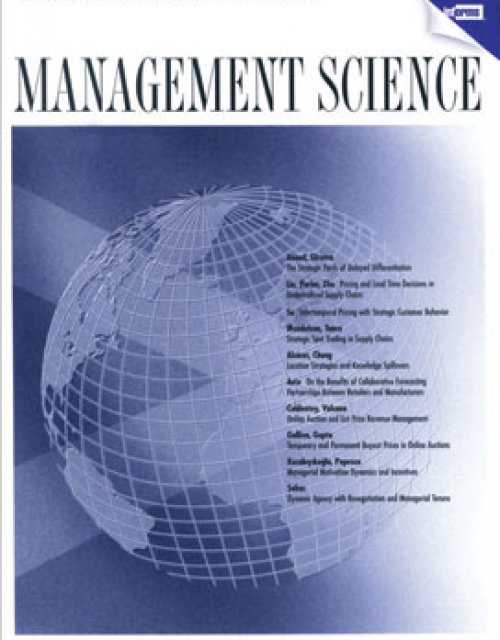Publication records
Subject(s)
Human resources management/organizational behavior; Strategy and general management
Keyword(s)
leadership development, leadership programs, executive education, transformational programs, teaching leadership
Secondary Title
SAGE handbook on teaching leadership
Pages
263–282
Subject(s)
Marketing
Keyword(s)
CR, CSR, sustainability, stakeholders, direct route, indirect route
The corporate social and environmental responsibility movement, known more generally as corporate responsibility (CR), shows little sign of waning. Almost all large corporations now run some form of corporate responsibility program. Despite this widespread belief that CR can simultaneously improve societal welfare and corporate performance, most companies are largely in the dark when it comes to understanding how their stakeholders think and feel about these programs. This book argues that all companies must understand how and why stakeholders react to such information about companies and their actions. It examines the two most important stakeholder groups to companies – consumers and employees – to comprehend why, when and how they react to CR. Armed with this insight, it shows how companies can maximize the value of their CR initiatives by fostering strong stakeholder relationships to develop, implement and evaluate compelling social responsibility programs that generate value for both the company and its stakeholders.
Pages
344
ISBN
978–1107401525
Subject(s)
Strategy and general management
Keyword(s)
negotiation, intercultural management
Subject(s)
Strategy and general management
Keyword(s)
negotiation, intercultural management
Subject(s)
Strategy and general management
Keyword(s)
negotiation, intercultural management
Subject(s)
Economics, politics and business environment
Keyword(s)
coordination games, organizational routines, decentralized information, ex-post equilibria, cursed equilibria, multi-agent learning, rational learning
JEL Code(s)
C73, D23
We investigate dynamic coordination among members of a problem-solving team who receive private signals about which of their actions are required for a (static) coordinated solution and who have repeated opportunities to explore different action combinations. In this environment ordinal equilibria, in which agents condition only on how their signals rank their actions and not on signal strength, lead to simple patterns of behavior that have a natural interpretation as routines. These routines partially solve the team's coordination problem by synchronizing the team's search efforts and prove to be resilient to changes in the environment by being ex post equilibria, to agents having only a coarse understanding of other agents' strategies by being fully cursed, and to natural forms of agents' overconfidence. The price of this resilience is that optimal routines are frequently suboptimal equilibria.
View all ESMT Working Papers in the ESMT Working Paper Series here. ESMT Working Papers are also available via SSRN, RePEc, EconStor, and the German National Library (DNB).
Pages
58
ISSN (Print)
1866–3494
Subject(s)
Strategy and general management
Keyword(s)
corporate social responsibility, competitive strategy, challenger brand, affective trust
This research builds on the complementary corporate social responsibility (CSR) literatures in strategy and marketing to provide insight into the efficacy of CSR as a challenger's competitive weapon against a market leader. Through an investigation of a real world CSR initiative, we show that the challenger can reap superior business returns among consumers who had participated in its CSR initiative, relative to those who were merely aware of the initiative. Specifically, participant consumers demonstrate the desired attitudinal and behavioral changes in favor of the challenger, regardless of their affective trust in the leader, whereas aware consumers' reactions become less favorable as their affective trust in the leader increases. Furthermore, participation, unlike mere awareness, transforms the nature of the consumer-challenger relationship from a transactional one to a communal, trust-based one.
© 2011 INFORMS
Volume
57
Journal Pages
1528–1545
Subject(s)
Ethics and social responsibility; Human resources management/organizational behavior; Management sciences, decision sciences and quantitative methods
Keyword(s)
Self-control, temptation, inter-temporal choice, pre-commitment
JEL Code(s)
D01, D03, D69, D90
We model self-control conflict as a stochastic struggle of an agent against a visceral influence, which impels the agent to act sub-optimally. The agent holds costly pre-commitment technology to avoid the conflict altogether and may decide whether to procure pre-commitment or to confront the visceral influence. We examine naïve expectations for the strength of the visceral influence; underestimating the visceral influence may lead the agent to exaggerate the expected utility of resisting temptation, and so mistakenly forego pre-commitment. Our analysis reveals conditions under which higher willpower – and lower visceral influence – reduces welfare. We further demonstrate that lowering risk aversion could reduce welfare. The aforementioned results call into question certain policy measures aimed at helping people improve their own behavior.
View all ESMT Working Papers in the ESMT Working Paper Series here. ESMT Working Papers are also available via SSRN, RePEc, EconStor, and the German National Library (DNB).
Pages
43
ISSN (Print)
1866–3494
Subject(s)
Human resources management/organizational behavior; Strategy and general management
Keyword(s)
coaching, executive coaching, management learning
Volume
9
Journal Pages
93–94
ISSN (Print)
1727-4192
Subject(s)
Marketing
Keyword(s)
Financial institution, private wealth management, investment banking, customer satisfaction
Die Finanzmarktkrise hat das Geschäftsmodell vieler Banken in Frage gestellt. Welche Lehren müssen die Banken daraus ziehen? Welche Konsequenzen ergeben sich daraus im Umgang mit den Kunden? Diese Fragen stehen im Mittelpunkt dieses Buches, dessen Beiträge von namhaften Fachleuten sowohl aus der Praxis als auch der Theorie stammen. Das Buch beleuchtet die theoretischen Aspekte des Client Commitment und die Facetten der bislang erfolgten Umsetzung in die Praxis.
Pages
288
ISBN
978–3867741521


